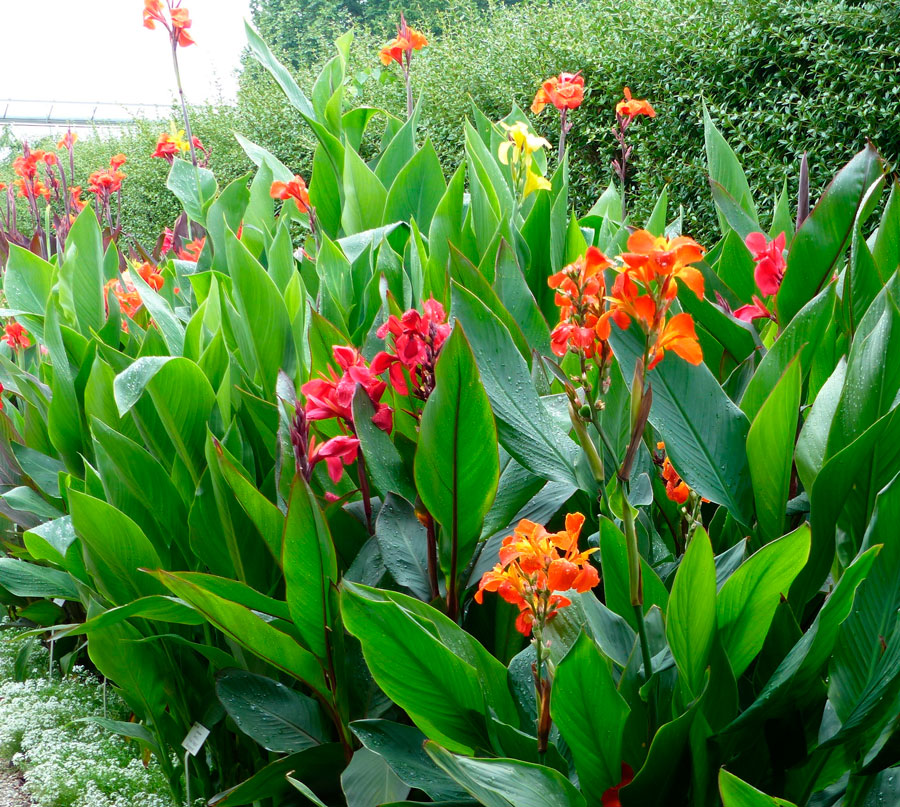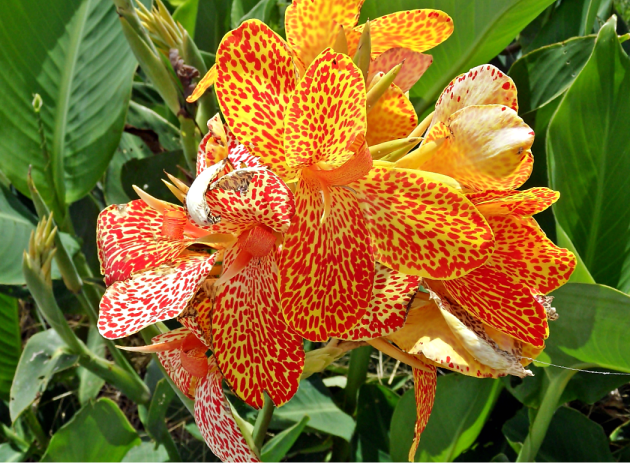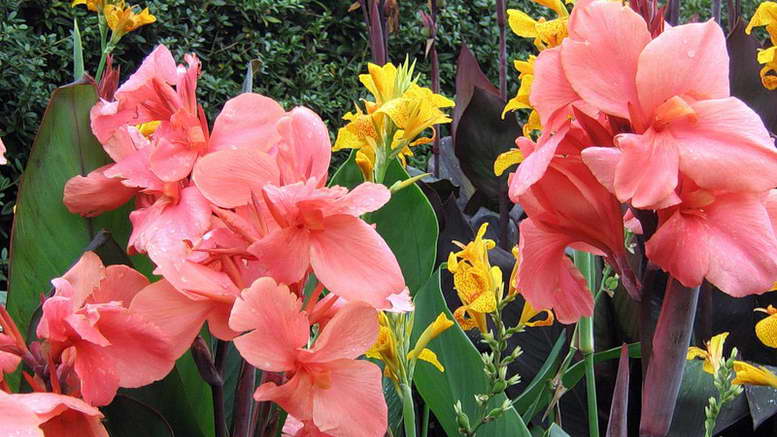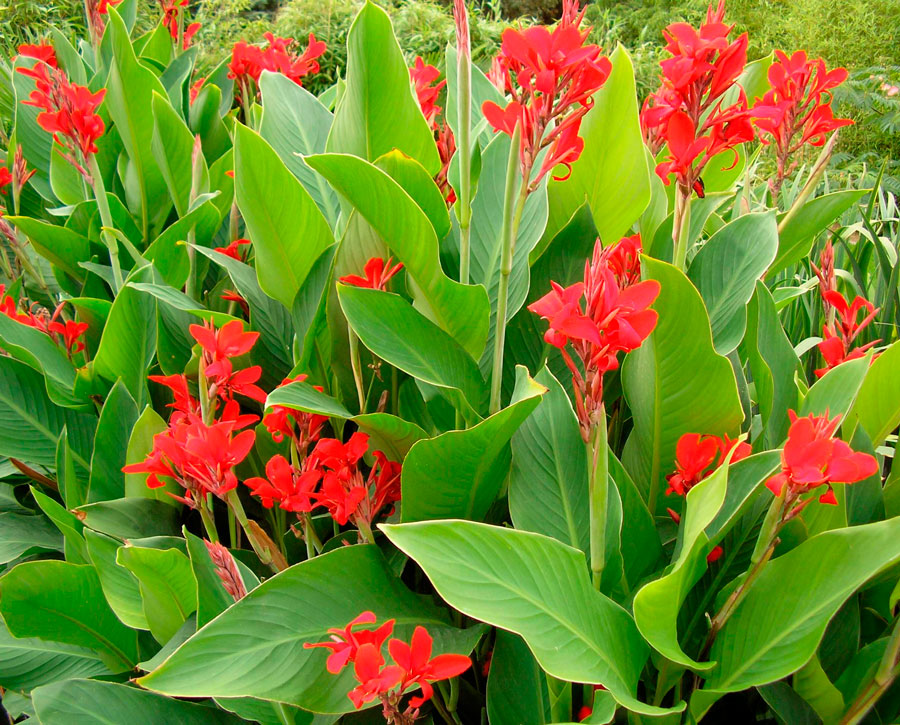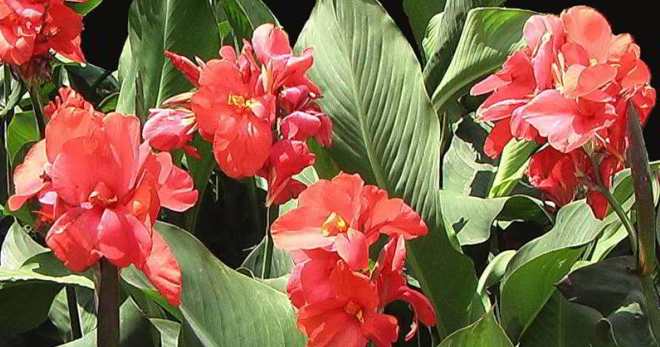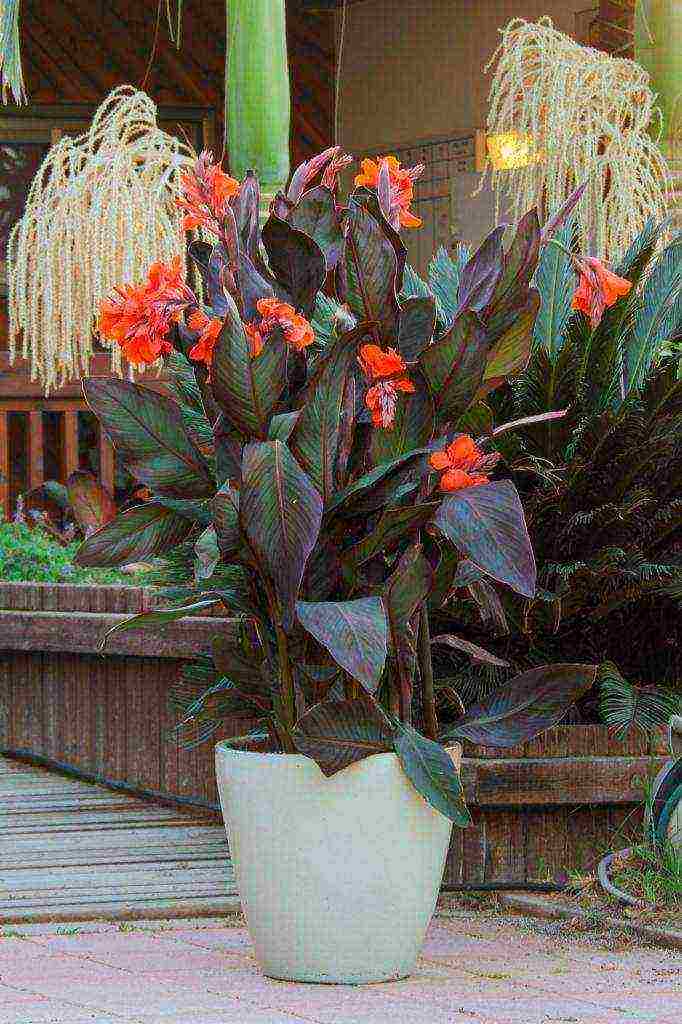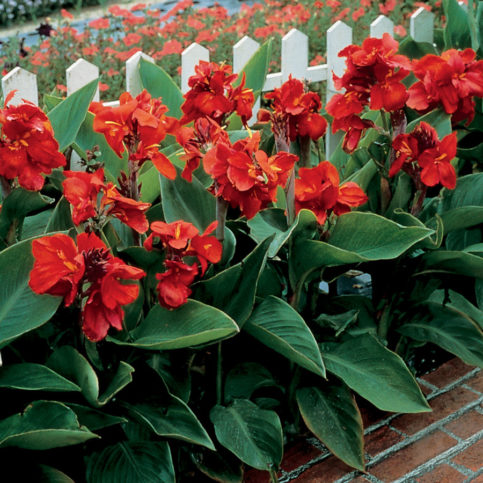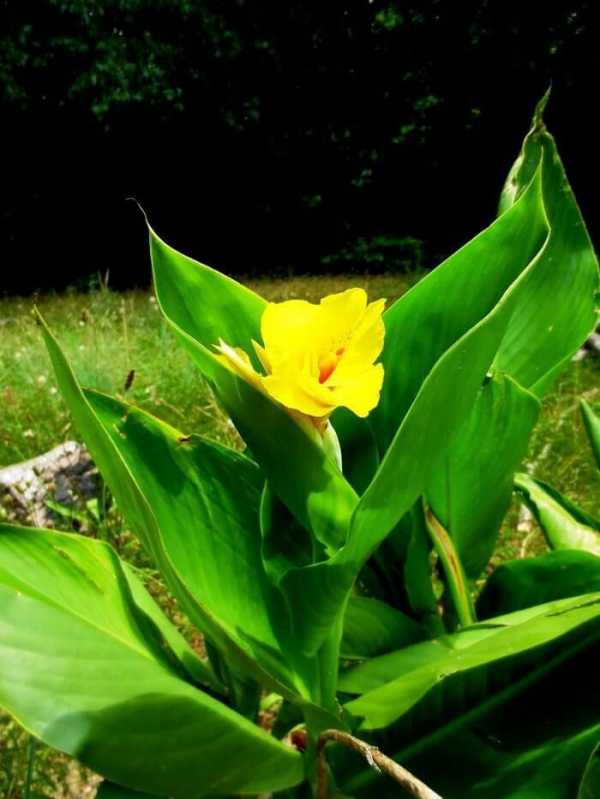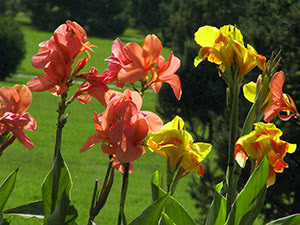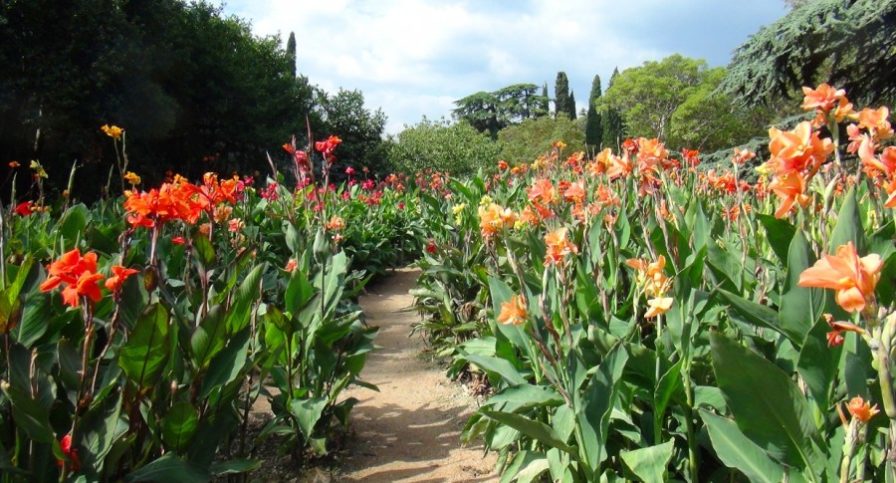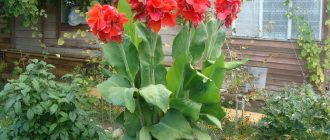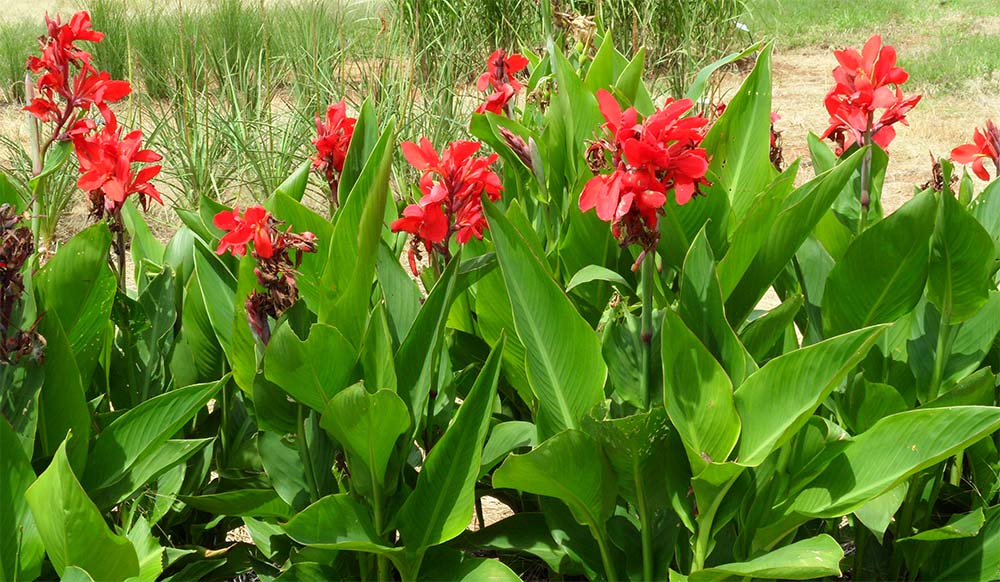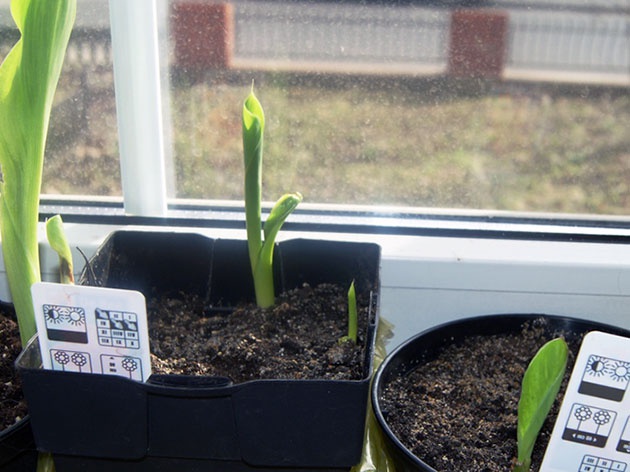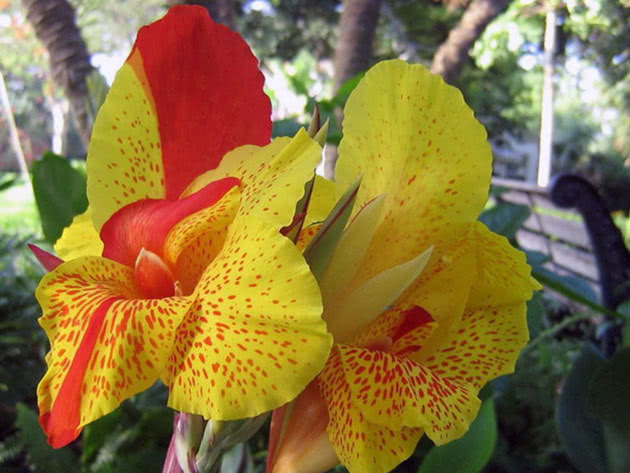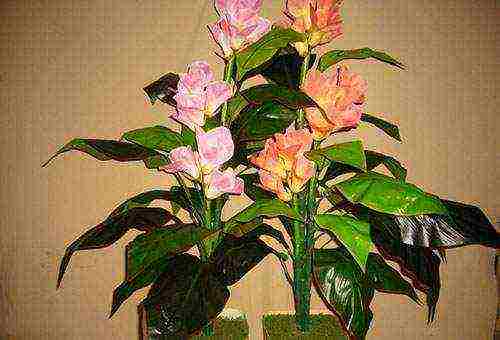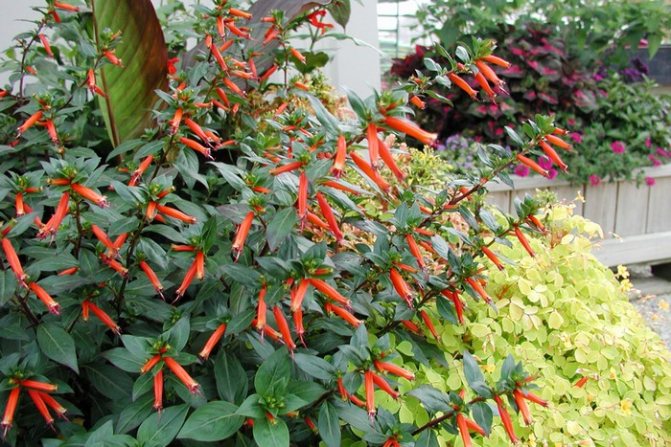Correct fit
As a resident of warm and humid places, the sunniest area in the garden is chosen for Cannes.
The flower must be reliably sheltered from gusts of wind, otherwise the tall peduncles may break. For especially tall varieties, it will be necessary to install strong stakes for the peduncles.
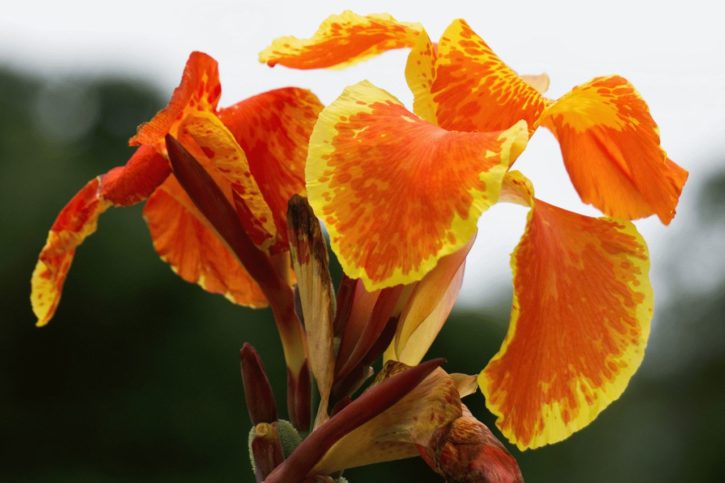 A loose soil rich in humus with good moisture capacity is suitable for the plant. It can be fertile loam and even sandy loam, provided there is sufficient moisture. Before planting cannes, at least 5 kg of good fatty humus (not fresh manure!) And about 4 kg of coarse sand are applied to the site. The soil is dug up to a depth of 35 cm, so the plant has a large branched rhizome.
A loose soil rich in humus with good moisture capacity is suitable for the plant. It can be fertile loam and even sandy loam, provided there is sufficient moisture. Before planting cannes, at least 5 kg of good fatty humus (not fresh manure!) And about 4 kg of coarse sand are applied to the site. The soil is dug up to a depth of 35 cm, so the plant has a large branched rhizome.
Advice. The flower responds positively to the "warm bed" device when a fresh mullein is applied to the bottom of the planting holes. The manure is spilled with hot water, covered with soil, with a layer of 25 cm, and only then the canna rhizome is planted. Burning manure generates heat, which warms the roots of the flower.
The flower is planted in May, when the threat of frost has passed. The distance between the bushes is maintained at 50 - 90 cm, depending on the size of the variety. The canna rhizome is immersed in the soil by 10 cm.
Planting clarkia in open ground
When to plant clarkia
Clarkia flowers are planted in open ground in May. If the soil in your area is not suitable for clarkia due to its pH, there are several ways to acidify it: add a kilogram and a half of peat or 60 g of sulfur per square meter to the soil for digging, or spill the soil with a solution of oxalic or citric acid at the rate 1.5 tablespoons per 10 liters of water. If the soil is too acidic, it is lime before planting, and if it is too greasy, the site is dug up with sand. Well, do not forget to apply the fertilizers that have already been mentioned. You need to prepare a site for clarke at least two weeks before planting.

How to plant clarkia
Clarkia is planted in this way: the seedlings are taken out of the container not one at a time, but in groups, together with an earthen clod, and are also planted in holes located at a distance of 20 to 40 cm from each other. Near each hole, you need to stick a stick or rail, which will serve as a support for the thin stems of the clarke when the bushes grow. Plant different varieties of plants at a distance from each other, because they can get dusty among themselves. After planting, the plants are watered and lightly pinched to stimulate tillering.
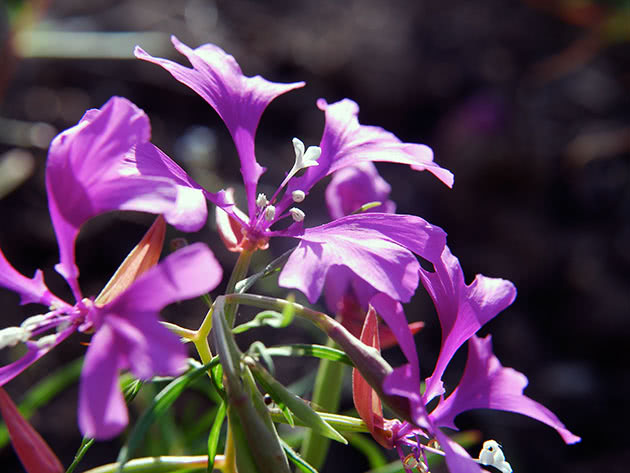
Types and varieties of cannes
Tall varieties of cannes
On a spacious lawn area, it is better to plant the following tall cannes varieties (height 1-1.5 m):
- America, Red Futurity - varieties with purple leaves and red flowers;
- Fire Bird and President are varieties with red flowers and green leaves;
- Crown and King Midas are varieties with bluish-green leaves and yellow flowers.
You can knock out groups of these cannes with the silvery cineraria of the seaside, then they will definitely not get lost among the greenery. Cannes are spectacular even in the evening, if you place garden lamps next to them.
Located in the central part of the parterre flower bed, Cannes will look even more beautiful. Especially if you plant them at different levels: tall with dark red and low cannes with pale pink flowers.
Low-growing varieties of cannes
Low-growing varieties of cannes (50-90 cm) can be planted on small lawns, placing in flowerpots on the recreation area or at the entrance to the house:
- City of Portland,
- Carpet,
- Lucifer,
- Pfitzer's Chinese Coral,
- Hungaria,
- Valentina Tereshkova.
The unquenchable flame will remind you of Cannes varieties with a color of flowers, in which there is a combination of yellow and red strokes:
- Picasso,
- Gold Lucifer,
- Partenit,
- Lucifer.
They are beautiful against the background of yews, junipers, they will revive the walls of large stones.
Cannes are often planted in decorative ponds. Such cannes grow all year round submerged by 10-20 cm in water. Only in summer in an open-air reservoir, and at subzero temperatures, they are transferred to a winter garden, where the temperature is +15 ºC, and are immersed in water. Adequate lighting is required for flowering.If the natural is not enough, then artificial illumination of the cannes is necessary, then the plants will continue to bloom and form new shoots.
 Growing cannes in the garden
Growing cannes in the garden
Cannes varieties for the reservoir
In the absence of a winter garden, the rhizomes in the fall must be washed, dried and sent for storage in the winter in peat or sand. Grow in water, the following cannes varieties can:
- Brilliant,
- Lucifer,
- Canna indica,
- hybrids of the Lonqwood group.
And if you compose an original composition of cannes and nymphs in a reservoir, then everyone who loves unusual plants will be delighted.
Where do the drops on canna leaves come from? They also say that Canna is crying. Since the canna is a tropical plant, it is endowed with guttation, i.e. the ability to release excess moisture - drops appear on the leaves. So with the help of Cannes, you will find out the weather forecast. Large droplets on the leaves will indicate high humidity, which indicates possible precipitation during the day or night.
Cannes landing

Cannes are planted in open ground after stable heat is established. If there are sudden changes in temperature, characteristic of spring, then the flower will stop growing, which will significantly delay flowering. Therefore, it is better not to plant it before the second decade of May.
For best results, you need to carefully prepare the site for planting cannes. For each plant, prepare a planting hole with a diameter of half a meter and a depth of forty centimeters. At the bottom of the hole, pour a layer of manure (15-20 centimeters), which will serve as a "heating pad" for the canna roots. Pour a layer of earth on top, with the calculation of planting rhizomes. Planting depth will depend on the size of the roots. Plant young specimens that did not have time to develop enough to a depth not exceeding 10 centimeters. Given the considerable dimensions of these flowers, the distance between the planted cannes should be made at least half a meter.
Kanna: appearance
Unusual bicolor canna flower As noted, the canna is a large plant with a thick, straight stem that does not need to be propped up. A healthy adult flower is capable of throwing three to four arrows. The height can be from half a meter to two. These sizes allow the flower to be grown both in soil and in flower pots. There is not much difference in leaving. Here are some of the characteristics of cannes: Cannes are perennial plants. Their thermophilic character is incompatible with the cold Russian winter.
Therefore, when wintering in open spaces, the plant most often dies. The features, and some consider this property a disadvantage, include the lack of smell. The flower blooms four months after the beginning of the development of the shoot. Flowering begins in July and lasts about two months, or even until the first frost. Canna is a large flower from 3 to 15 cm in size, reaching 30 cm in inflorescences, colored in any shades of yellow, red, burgundy and orange. 10 mm is considered standard. Most often it is colored red, less often yellow shades are present. The unique is the snow-white color. It can be both plain and speckled, stripes. On the stem of the cannabis, there are leaves of a large oblong elongated shape, which are distinguished by significant sizes.
They can be up to 80 cm. Delicate canna flower of the Salmon Pink variety. Cannes are thermophilic plants, therefore they do not like early planting in open ground. But it is worth considering the fact that the earlier the flower begins to develop, the faster it will bloom and begin to decorate the flower bed. Therefore, for planting, they use such a technique as sprouting a flower in advance and due to this artificially helping to start flowering earlier. Some canna varieties grow well in water containers. In this case, in summer they are seated in an open reservoir on the site, and in winter they are transferred to a winter garden. With this planting order, it is additionally necessary to provide for artificial lighting of the flower, the winter sun will not be enough for it.The temperature required for plant growth is 15 degrees.
Outdoor care
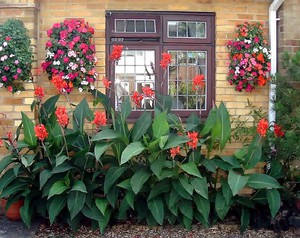 In open ground, such a plant is planted only in the southern regions. At the same time, places are chosen with high illumination and protection from strong winds. Disembarkation takes place in April, there are no special requirements for the soil mixture. The soil should be loose and not allow a large amount of water to stagnate, well drained and fertilized. Previously, a hole is pulled out in the ground: the planting depth does not exceed ten centimeters. Plants are placed at a distance of up to 1.5 m and covered with soil on top.
In open ground, such a plant is planted only in the southern regions. At the same time, places are chosen with high illumination and protection from strong winds. Disembarkation takes place in April, there are no special requirements for the soil mixture. The soil should be loose and not allow a large amount of water to stagnate, well drained and fertilized. Previously, a hole is pulled out in the ground: the planting depth does not exceed ten centimeters. Plants are placed at a distance of up to 1.5 m and covered with soil on top.
Care is concluded in periodic watering, it is especially important when flowering. After a few days after watering, the soil needs to be slightly loosened, while all weeds are eliminated. With the time the culture fades, the arrows and the inflorescences that have arisen are eliminated. This will give the crop a more graceful look and stimulate the buds to develop new growth.
Growing seedlings is considered the most popular option. Landing features:
- To begin with, the rhizomes are sorted out and divided into separate parts. The cut sites are well processed.
- The roots are dried.
- They are placed in a container, and then calcined sand is poured on top.
- Watering is carried out every other day.
- Roots grow best on a sunlit window in an apartment, especially if the container is located above the radiator and warms up regularly.
- With proper care and planting, the plant sprouts after a few weeks.
- After the leaves appear, the culture is transplanted into a new container, where it continues to grow as seedlings.
This method of growing seedlings is considered more successful and helps to get a stronger crop that can bloom for a long time. In a cool climate, when planting in the very soil of an unsprouted rhizome, there is a high chance that the flower simply will not have time to bloom.

Seedlings are planted in the ground at the end of May. At this time, the soil must be warm and you must be sure that the frost will not return. Seedlings by this time should already grow decently and become more robust.
 It is best to plant the plant in pre-fertilized soil. Organic preparations or minerals are used as fertilizers. To significantly accelerate the growth of culture, various agricultural techniques are used. The method of creating optimal thermal conditions has become more common.
It is best to plant the plant in pre-fertilized soil. Organic preparations or minerals are used as fertilizers. To significantly accelerate the growth of culture, various agricultural techniques are used. The method of creating optimal thermal conditions has become more common.
Follow-up care will include watering once every ten days. The culture is watered using the root method. Over time, fertilizers are added to the soil to stimulate crop growth.
When flowering, it is very important for a crop to ensure good watering.
3 Growing garden canna
In the garden and flower beds, cannes are grown in two ways.
The first method is growing from seeds. It is rarely used. Not all seeds sprout, and varietal characteristics are rarely preserved with such a planting. And if the seed method is chosen, it should be understood that the grown flower may differ from the original canna.
To prepare the seeds for planting, you need to know that their shell is quite hard, it is supposed to be softened. This process is performed according to the following algorithm:
- Pour boiling water over the seeds.
- Leave them in warm water at a constant temperature for 3-4 hours.
- Keep the seeds for about 12 hours on a hot radiator.
- Placed in a freezer for a couple of hours to freeze.
The sowing month is February. Containers are filled with the prepared substrate, grooves are made and seeds are planted in them. The containers are left in a darkened room, where the temperature is maintained at about 22-23 ° C, for 25-28 days - until shoots appear. If 3-5 leaves have appeared on the shoots, the shoots dive into the prepared containers. The temperature can be reduced to 17 ° C and the material can be kept indoors for some time. Then transfer to the ground. Flowering can be expected soon, but sometimes this only happens the next year.
The second way is grafting. As a result of cultivation, the shade of the canna will be the same as that of the original plant. And flowering will definitely come this year. The grafting process is carried out according to the following scheme:
- In early spring, the rhizome is disassembled into parts (delenki), each of which may contain one strong and large bud or many weak ones.
- Sections are covered with crushed coal. Dry.
- The plots are laid out in a heap on the ground or sand, and the kidneys are placed in a horizontal plane.
- The material is covered with sand and is waiting for germination.
- Do not let the roots dry out. To do this, the sand is regularly moistened with warm water. The temperature regime in the room should be above 21-24 ° C.
- When leaves appear, cannu can dive into small vessels until planting in the ground, maintaining the temperature in the room within 16-17 ° C.
- Plants will be stronger if watered with a mild potassium permanganate solution every 10 days.
Germination can be avoided and the planting material can be placed directly into the soil. However, one cannot hope for an early flowering. Therefore, a more reliable option is crop germination.
How to propagate a flower and properly prepare for planting in open ground
Canna is a perennial plant. You need to plant it on the site once, and then:
- take care of it properly,
- dig up for the winter;
- master the rules of preparation for planting in the spring.
There is nothing complicated about that. Novice growers just need to use the existing recommendations.
At the beginning of spring, it is necessary to get the rhizomes harvested from the fall, clear of the ground, without damaging their base.
Step 1. Cut the tuber using a sharp knife.
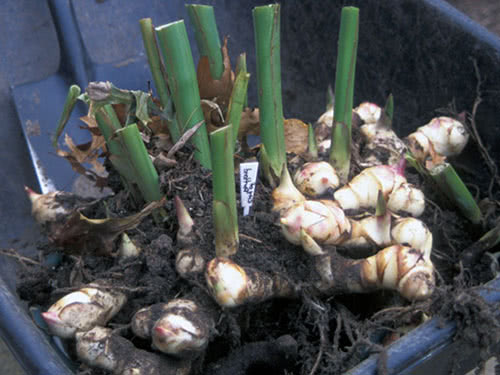
Cannes tubers
Step 2. Places of incisions must be treated with crushed charcoal or activated carbon - this will not allow the development of infections in damaged tissues.
Step 3. Cut the prepared roots, leaving 5 centimeters in length.
Step 4. Leave the planting material to dry in a dry, warm room for about 3 days.
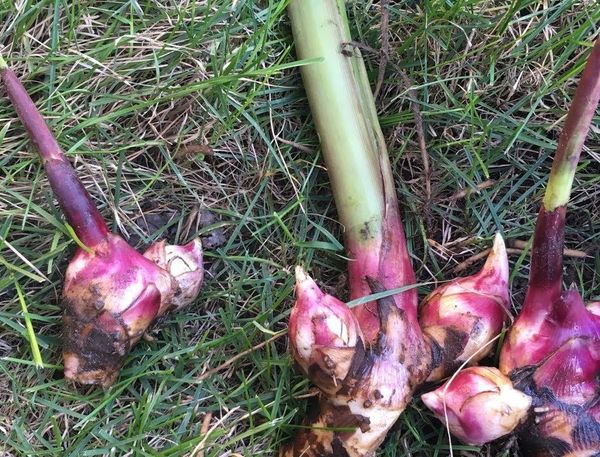
Planting material
Step 5. During this time, maintain the temperature in the room from +10 to +15 degrees.
Step 6. Before reproduction of a flower, you need to carefully examine the roots, removing damaged areas
Step 7. When sprouts appear on the cuttings, plant them in containers with a prepared nutrient substrate and put them in a greenhouse or other heated room.
When frosts completely recede, the soil warms up well, you can start transplanting germinated flowers. The soil must be prepared in advance:
- dig up;
- remove weeds;
- if necessary, apply a suitable soil mixture.

You can transplant a plant into open ground from preparatory tanks with the arrival of constant heat




